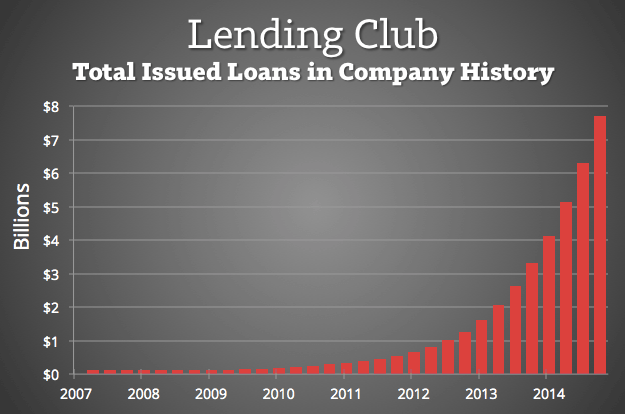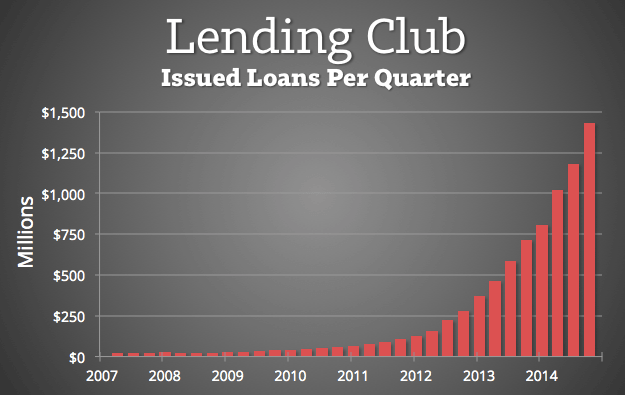A few weeks ago I had the chance to visit Lending Club’s headquarters in San Francisco. This was my first visit since the company had gone public in December (read about the IPO here), so I was curious to see if things were at all different at 71 Stevenson, particularly as their stock had dropped after a recent earnings call. Since becoming a publicly traded company, had Lending Club changed?
I brought this question up with a number of employees. And while everybody remembered the IPO with great pride, celebrating their company’s day in the national spotlight, few seemed to care about the daily tickings of the new stock. Indeed, the growing company seemed pretty much the same as I had left it: focused, patient, and passionate about its mission, something I think you’ll read in this interview with the company CEO.
Interview with CEO Renaud Laplanche
Lending Club continues to lead the online lending industry. Last year you hired several hundred new employees, took over four more floors in your building, and issued an incredible $4.4 billion in new loans. Growth is near a half billion dollars of new loans per month. How are you doing this?
Laplanche: We continue to be very deliberate about our growth. Over the last three or four years we have been in this great position where we have not been either supply or demand constrained. As we activate more channels on the borrower side, we let in more people on the investor side.
One thing we are acutely aware of is to make sure we don’t grow too fast, causing operational mistakes. We are dealing with people’s money, so it puts additional responsibility on us to manage growth in a way that doesn’t put our customers at risk.

Would you consider Lending Club to be more of a financial or tech company?
I think we’re a technology company that delivers financial services. Both components are really important and need to be combined. If you look at our workforce, we do have typical Silicon Valley engineers and marketers, but we also have people who come from banks and financial service backgrounds. Our ability to hold these two together, to exchange their ideas, and to take the best of both worlds is what makes us unique.
For example, as you walk around our office, you can see a lot of collaboration spaces, a lot of reasons to move from one floor to another. Technology and finance are always interacting at Lending Club. At times, our elevator can be a bit of a traffic jam.
With the IPO in December, it seemed like your $8.5B valuation suggested Lending Club to be more of a tech company.
I think these valuations are more common for tech companies because technology-enabled companies tend to grow faster, and valuations essentially depend on revenue and margin growth. It’s worth noting that there are no banks growing at 100% each year.
This is true. After your last earnings call, the company’s stock fell 13%. A fair number of news organizations published stories with needlessly dramatic titles like “Lending Club is crashing”. What happened?
A couple of things. First, like any company that’s just had an IPO, we couldn’t share our earnings estimates until the first earnings call, so analysts had to create their own projections about how fast we should be growing without our input. Our earnings call was a way to help these numbers converge, so now we’re better set up for future quarters.
Secondly, what also contributed to the excitement among investors were the partnerships we announced over the past few weeks with Google, Alibaba, and BankAlliance. While we expect that these partnerships will help us grow our business and create value for us over time, some investors may have factored them into their expectations of us in the short term.
So, in a nutshell, the stock went down on February 25th because…
… no one can say for sure, but some investors may have expected higher numbers than we reported in our internal guidance.
It almost sounds like this correction was healthy.
On the day of the earnings report, the stock dropped essentially back to where it had been 3 weeks earlier. That said, everyone at Lending Club is not really focused on daily stock variations. We are far more focused on building value for the long run.
Let’s talk about the experience of the average Lending Club investor. How might it change in 2015?
We are eager to open new states. We already opened up Massachusetts in December, and are hoping to open up further states over the course of the year. One of the byproducts of the IPO is the ability, we hope, to get into more states over the course of the year.
Recently, your Automated Investing tool removed its A-B grade only button and added a D-G grade button. Does this indicate a shift at Lending Club towards feeling more comfort in suggesting more risk to their investors?
No. We simply looked at investor behavior, what they were actually investing in, and tried to make it easier for them to make those choices. It was more of a bottoms-up adjustment.
An important issue is how interest rates have dropped over the past year. This seems to be investor returns finding equilibrium with borrower demand.
That’s right. It is finding a balance between supply and demand. In a situation where we have so much additional investment coming to us, we could do one of two things: the first option would be to restrict investors’ ability to invest or to charge a higher fee.
The belief is that part of the rate cut will be absorbed by lower defaults.
The second option, which is more beneficial to borrowers, is to lower the interest rate. This was what we chose to do, and by doing this we believe we can generate more positive selection. For example, this means people who now take a 10% loan offer, but who would have rejected a 12% offer, are typically also higher quality borrowers. So the belief is that part of the rate cut will be absorbed by lower defaults. Even though interest rates have dropped by something like 1%, the reduction in investor returns should actually be less than that.
Most say the future of retail investing is being included in something like a Charles Schwab account. Do you see Lending Club starting to integrate itself with Charles Schwab and Betterment? How would that happen?
This is one of the things we are thinking about, and it could happen in one of two ways. The first is a technology-integration approach that helps the investor simply buy notes through a retail account.
Similar to third-party API tools like LendingRobot.
Right. The other is creating a fund that would be available just like any other mutual fund or ETF.
And which of these seem more probable to you?
I think both are possible over time. The question is just a matter of which one we tackle first.
I’m amazed how Lending Club contains this thriving population of retail investors, tens of thousands of people investing in $25 increments. This is a unique and powerful narrative within your company.
Definitely. Serving our retail investors helps us to stay true to our roots. But it is also a great business strategy. We believe small-dollar investors will continue to be predictable and loyal to us, especially during a decline in the national economy. Many invest through a retirement account, which is an even longer-term commitment, and a great option because the interest grows each year in a tax-deferred structure.
Late last year, Lending Club reduced the data it made available to the public. Around 44 borrower variables got removed. Can you talk about what happened?
Sure. I think it was reported as Lending Club becoming less transparent, which was not the intent. What we did was take away some variables that had been added in 2010 at the specific request of a large investor – we hadn’t wanted to give an institutional investor more data than our retail community, so we opened it up to everybody.
However, over time we realized that these data points were not being used by retail. Instead, we found that other emerging companies were using them to build competitive credit models, so we removed the data.
It’s true that retail did not use these data points, but many of us value the protective element of this data that allows us to examine the quality of your loans. Many, including myself, are concerned that this is a trend away from the open data.
I don’t see any trend. This just happened to be one particular situation that began and ended over the past few years.
So the open data is a permanent fixture of your company?
Yes. We have no plan to change it.
Let’s switch over to investing best-practice. For a long time, it’s been said that lenders should only place 10% of their overall investments into peer to peer loans. For me, this allocation seems too conservative. Do you see it increasing?
I think it should. As marketplace lending becomes more mature, and we have more risk management tools available, I think advisors should consider relaxing that guidance. But it really depends on people’s situation. If you are in your fifties or sixties, and more of your portfolio is fixed income, maybe you can go a bit higher.
This leads to a good question. Investments are typically categorized as equity or fixed-income. Are these loans fixed-income like bonds?
This seems to be the case, though they have components of both bonds and equity. They are fixed-income in that this is an investment in debt, and it pays a yield every month. That said, these loans are not as liquid as bonds, yet have a higher return that compensates for the lack of liquidity. Further, they have short duration and high cash flow. With components of both bonds and equity, consumer credit is almost its own asset class.
Some still compare this investment to junk bonds. How would you respond?
In terms of a return, we have been doing just as well as the high-yield bond market, and sometimes beating it. On the whole, we believe returns on the Lending Club platform have been more consistent over time than most high-yield bonds.
It almost sounds like this critique will pass with time.
There have been many skeptics all along, but I think most are starting to come around.
Let’s talk about the culture here at Lending Club. Every time I visit, the space and the people here leave me feeling so positive. How has your team created such a consistently friendly company?
This happens through patiently applying our mission to everything we do. There are two things visitors to Lending Club usually tell us. First they say, “People are always smiling. They seem happy to be here.” Yet at the same time they say, “People here walk fast.”
When someone visits, what they experience is a team that is excited to transform the banking system.
This was our intention. We want people who want to be here, for whom it is not just a job but also something they desire to do. We recently constructed our roadmap for 2015, and every single goal was tied back to the mission. We asked ourselves how each goal makes credit more affordable and investing more rewarding. So when someone visits, what they experience is a team that is excited to transform the banking system and make it more transparent and consumer friendly.
Imagine, back when you started this company, that you had approached your earliest investors and said, “I have a great idea, but I need six years and four hundred million dollars.” Would they have bought it?
(light laughter)
Clearly not. The typical approach in Silicon Valley is to raise a small amount of capital, start building the prototype and show it can work. This then gives confidence to the next investor to come in, and you can then build a little bit more with that new money. It’s sort of a stepping-stone path to growth.

In closing, where is this investment headed in 10 years?
What I’m excited about is more options for investors. Perhaps you can still come to the site if you like that experience and you want to be involved in the loan selection, but you can also buy shares in a fund through your Schwab account, or buy actual loans through a different account. Maybe you can invest in different products like insurance. There will be other options.
Perhaps small business loans? Will those become open to average investors?
Probably not right away. We need to better understand the data and dynamics before we open small business loans up to retail. What might happen is that these loans contain a range of credit quality like personal loan grades A-G, so perhaps we would open up business grades A-D to retail since they are the most predictable.

Simon, great interview. One question I’d like to have answered would be the swings of volume within a particular quarter. If we look at the last two quarters of 2014 (using NSR), you can see the volume fall in each successive month of a quarter. This is something that has been noted elsewhere on the web, and I’d like to know what the response is to what appears to be some fairly obvious manipulations.
Volume Notes Average Size
July 433,044,725 29,306 14,776.66
August 281,426,975 18,814 14,958.38
September 159,444,175 10,606 15,033.39
October 571,760,975 38,783 14,742.57
November 373,466,650 25,054 14,906.47
December 158,391,575 10,307 15,367.38
Great question. I’ll keep that in mind for a next interview. What are your concerns around manipulation?
Nothing specific, besides understanding why they are adjusting the flow rate of loans that significantly. It makes it look like they are extremely focused on hitting a certain growth figure, and the manipulation is a way of doing that. Just compare December to October – you’re talking about a 73% drop in volume. Likewise, compare September to July, and you end up with a 63% drop. Sure the holidays might have factored in, but not to the tune of that sort of manipulation. Just compare prior quarterly periods at any point prior to the last two quarters of 2014.
A follow up would be why not let organic growth occur without the monthly throttling? What do they perceive as the benefits from cycling loan volume like this?
Again, I’m not assuming anything nefarious, just want to understand the business purpose of pushing four times the volume in one month versus another. This has to put some serious strain on their resources to ramp up and down like that, and frankly just doesn’t make sense.
I agree with the comment: Excellent interview. Well presented questions with very clear and informative answers.
Thanks Gabrielle.
Great interview, very informative.
Curious though, Simon – do you have any criticisms at all about LendingClub? Also, can you please confirm for your audience that you receive no compensation from any p2p lender in any form.
Thank you.
Hi John. I have many critiques toward Lending Club. Eg, the “Open Data” article I wrote and linked to above. This site is produced without bias. As for compensation, this site does have affiliate agreements with both platforms as stated in the affiliate policy in the footer.
I would have liked you to ask Renaud why retail investors are not being offered the same counter-party protection through a bankruptcy remote vehicle as institutional investors have demanded and received, and which Prosper has managed how to figure out and do. Without the protection of a BRV, regardless of how many notes a retail investor purchases for diversification purposes, the diversification may only be an illusion.
Great question Alan. Typically the answer is that the Blue Sky exemption that opens up all 50 states post-IPO is only possible without using a bankruptcy remote vehicle, so that may be why they’re opting to do it that way.